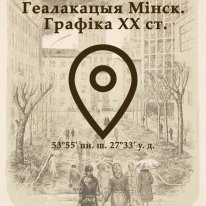“Geolocation Minsk. Graphics of 20th century" exhibition
- 11.09.2020
The National Historical Museum of the Republic of Belarus presents a new “Geolocation Minsk. Graphics of 20th century" exhibition.
The exhibition is timed to the City Day, which Minsk traditionally celebrates on the second Saturday of September. In 2020, this date falls on September 12 and the capital celebrates its 963th anniversary.
The exhibition will feature about 30 paintings and graphic works from the collection of the National Historical Museum of the Republic of Belarus, among which you can see familiar locations, squares and streets of the Belarusian capital. This is a kind of retrospective of the last 200 years of Minsk's existence, where each period is remarkable for its own peculiarities, significant events for the townspeople: urbanization, development and military destruction, the construction of new microdistricts and the revival of the historical center, city holidays and everyday life of Minsk residents.
Famous artists and less popular authors act as historiographers of the Belarusian capital, they reflect it in their own way on canvases and paper, but each of them manages to convey what is called the soul of the city.
Thus, the works of Viktor Stashchenyuk illustrate the appearance of Minsk at the beginning of the 19th century. Thanks to the works of Nikolai Duchits, we know how Minsk looked like in the pre-war period, during the period of occupation and destruction.
Painterly and graphic works of the 1950s – 1960s are imbued with the atmosphere of a large construction site, hope for a wonderful bright future, and the mood of a peaceful and calm life. This period is reflected in the works of Anatoly Tychina.
The works of the 1970s – 1980s show nostalgia for the old city, interest in the historical heritage, as well as new processes of the dynamic development of the city. Among the authors of this time, the works of Ekaterina Poplavskaya stand out: works of art are permeated with an interest in urban architecture, are distinguished by some "urbanism", mastery of graphic techniques.
Graphic works are capable of conveying many nuances and details, they perfectly reflect the transformation that Minsk underwent throughout the 20th century - with its both destructive and creative tendencies.
The presented works of art are interesting documentary material for researchers of architecture and urban life.
For visitors
opening hours
Open: 11.00–19.00
Daily
Ticket desk open: 11.00 – 18.30
Visitors enter: 11.00 – 18.30
admission
Adults:
Permanent exhibitions tour –
Br 10 BYN
Guided tour –
Br 30 BYN
Full-time students:
Permanent exhibitions tour –
Br 8 BYN
Guided tour –
Br 25 BYN
Schoolchildren and specialised secondary school students:
Permanent exhibitions tour –
Br 5 BYN
Guided tour –
Br 15 BYN
Retirees:
Permanent excibitions tour – 5 BYN
Guided tour – 15 BYN
Contacts
12 Vulica Karla Marksa, Minsk, 220030, Republic of Belarus
+375 17 3237665
+375 17 3748322
+375 17 3654827
histmuseum@histmuseum.by
Scientific department
office@histmuseum.by
Museum reception









